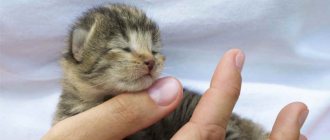Tame your kitten to sit in your arms from childhood
The easiest way to accustom a kitten to yourself is from childhood, namely up to 8 months.
Tame your Briton from childhood.
You can hand feed him and then put the treat on your lap. Fascinated by food, he will definitely jump after it, and while he is eating, you need to gently pet him. Soon your hands will begin to evoke positive emotions in the kitten.
Little kittens are terrified of heights, so it's best to pick up your baby while you're sitting. You need to hold the kitten carefully, without holding it by the body near the ribs and withers.
This may hurt him .
You need to hold him by the armpits with one hand, and support his hind legs with the other. This way he will feel balanced and the fear of heights will disappear. If the kitten feels calm, the problem will be solved.
Owner's robe and scent
The cat is used to the smell, and remembers it among the smells of the street on winter clothes
Many people advise purchasing a soft terry robe and placing the baby in its pocket. He will get used to it, begin to consider it his property and may even want to sleep with it. And your smell will become dear and beloved to him and will remain in his memory for many years.
Taming methods
First of all, you need to leave the cat alone and give him freedom of action. This will relieve stress, and the pet will understand that it can make its own decisions and choose places to rest. Express kindness and affection when the cat is in the mood, but do not pick him up. For example, pat him on the head when he asks for food. If your cat jumps on the sofa while you're sitting on it, you don't need to drag him onto your lap. Show that you respect personal boundaries. You can call him to you, point to a place nearby, but if the pet doesn’t move, stop trying. Also try inviting him onto your lap during play, when the cat is active and ready to jump on any surface.
You can cheat a little and smear your hands with valerian or lure them to you with food. To prevent the cat’s goodwill from being short-lived, do not squeeze or grab the pet as soon as it jumps onto your lap. Let him look around, let him lick the treat off his hands, then pet him between the ears and let him jump off. This will help the pet understand that it is safe to sit on your lap and in your hands, and over time the cat will begin to come on its own.
You won’t be cute by force, so if no amount of persuasion or action helps you get used to being handled, you should put up with such aloofness from your pet. Perhaps the cat needs more time than it seems, and with age he will get used to the owner and still begin to jump onto his lap on his own. The main thing is to show that you respect the cat’s boundaries and are ready to accept his peculiarities.
Photo source:
We teach a British cat affection step by step
British from hand sitting
You need to accustom an adult animal to affection gradually and little by little. At first, you can gently and carefully scratch your Briton behind the ear (many cats are delighted with this) or stroke it, and this should be done only in the direction of growth of the pet’s fur. But under no circumstances grab him or squeeze him.
. If the cat begins to nervously beat its tail and show irritability, immediately leave it alone.
It is better to show affection when the cat has just woken up or goes to bed. Every day there should be more “portions of love”.
Sleep and the hands of the owner
Be sure to encourage any gentle impulses your pet makes in your direction; you can let him sleep with you. If the cat sleeps separately, carefully pick him up while he sleeps. It is quite possible that lying on them, he will continue his sleep.
When you feel that he is already accustomed to stroking, you can try to pick up your pet.
. If the cat starts to struggle, you should not hold him by force. This may frighten or anger the Briton, and it will be very difficult to win his favor again.
We quickly accustom a kitten to hands (British, Scottish)
How to train a cat to sit quickly in your arms? The complexity of this process largely depends on the age, character, temperament, breed characteristics, and upbringing of your mustachioed pet.
For example, a British or Scottish fold kitten will take longer to train. As a rule, kittens develop socialization skills around the second week of their life. Therefore, from now on, you can carefully pick up the kitten in your arms, gradually accustoming it to hands and affection. The process of socialization and adaptation should be as favorable as possible for a small pet.
Accordingly, the sooner you accustom an animal to communication, the faster and easier it is to achieve the desired result. Even if you got a cat and he is not six months old, with the right approach, accustoming the animal to your hands and raising an affectionate pet will not be difficult. Especially if the cat had a positive experience in communicating with the previous owner or with a person.
- During the first days, do not bother your baby with your excessive attention. The little pet explores a new territory, gets used to the smells and surroundings. Everything is interesting and curious to him.
- Protect the animal from stress, communicate with the kitten in a gentle tone, but at the same time pay attention to the cat as much as he wishes.
- Do not squeeze or forcefully hold the animal in your arms if it breaks out. If the kitten meows, lower the pet to the floor, caress, calm, stroke, interest him with a toy.
- At first, you need to hold the kitten in your arms for no more than 3-5 minutes, gradually increasing the time. Talk to the kitten in a gentle tone, treat him with a treat, and interest him in playing together.
- You can take a feather and play with your baby when he is on your lap. As soon as the fluffy gets used to it and begins to trust the owner, he will sit peacefully and more calmly in his arms.
Advice! Pet and pick up a sleepy, just woken up kitten. Hold him in your arms for at least a few seconds. Over time, the baby will understand that the owner’s hands provide not only food, but also pleasant sensations.
If you want to pet a kitten and pick your pet up, do it as carefully as possible. The animal should not experience any discomfort or pain. Hold the kitten by the front legs while supporting the back legs. The pet will not like sudden movements and lifting, and he may be afraid of such actions.
Teaching a British cat to sit on your lap
Place something tasty in your palm and offer it to your pet.
Pieces of meat, sausage, special food or vitamins are perfect for this.
While the cat is busy eating, pet him quietly. Gradually he will begin to get used to his hands. And then it will be possible to lure him to his knees. The animal should develop a pleasant association with this. So the next time your Brit wants a special treat, he can give you a hint by jumping on your lap.
Sprays and catnip
Use catnip, it's like a drug for cats.
Sometimes owners resort to using cat sprays
containing pheromones.
You can spray your clothes or hands with the product to attract your pet. Usually cats follow their owners as if spellbound to inhale the aroma. But you can’t abuse this - sprays quickly become addictive
. You can replace them with catnip.
Attract your pet with a toy
Cats love to play at any age.
The process of play brings the animal very close to the owner. First, you can play “cat and mouse” with a rope on the floor, gradually bringing it closer to you. And when the animal is on the verge of excitement, throw the “mouse” on your lap.
When the cat is in your arms, you need to release the string so that the cat can heartily enjoy its prey. This way, on an unconscious level, you will become accustomed to your hands and knees.
If an animal bites or scratches you during play, you should never beat or scold it. British cats are very touchy creatures and may not forgive such an act, and you can completely forget about accustoming your pet to handling.
How not to behave around a cat
Cats are quite freedom-loving and touchy creatures. If the owner has ever offended the cat, the cat will never approach him again. And you can’t even dream of him jumping onto your lap. If the cat receives affection and attention from the owner, then gradually he will get used to the person and respond with mutual affection.
It should be remembered that cats will never do anything against their will. There is no need to forcefully hold them on your knees; this still will not lead to the desired result. The animal itself must want to sit or sleep on its owner’s lap.
If a small kitten tolerates the owner’s caresses normally, then at the first sign of anxiety, it should be released. When the animal begins to nervously beat its tail on the floor, it says that I’m tired, I have a lot of things to do.
Does a British cat not sit on your hands because of its origin?
I will lie anywhere, but not sit in your arms
Perhaps the British dislike for excessive affection lies in the history of the origin of this breed
. There are several versions about this:
- Large gray cats with amber eyes were brought to the British Isles by the ancient Romans
. - French sailors
acquired huge gray cats from the monks of Grand Chartres to protect food cargo on ships from rodents. Their ships regularly visited the shores of Britain. Therefore, some cats could remain on the shore. - The breed of British cats with wide cheekbones, large expressive eyes and thick short hair was formed as a result of crossing immigrants with local tabby wild cats
.
Independent character of British cats
British cats have their own, independent and different character
Judging by the history of the origin of this breed, it can be argued that the independent character of the British comes from the harsh life on French ships,
where none of the sailors coddled with them. Life among ascetic monks and proud Romans also left its mark on the independent character of these cats.
For centuries, their role was to live among people, mind their own business and earn their basic food.
Wild cat Tabby
The blood of the Tabby wild cat also played a role in shaping the self-sufficient character of the British cat.
Characteristics of a British cat
British cats are distinguished by their intelligence and intelligence. When handled skillfully, they even... However, adapting their behavior to the mood of their owner, representatives of this breed under no circumstances lose their dignity.
For these cats, freedom and independence are a priority
These qualities are more developed in British cats than others.
. Despite the centuries-old history of the existence of this breed next to man, the animals did not completely submit to his authority. In many cases, the opposite happens: the cat inevitably dictates terms to its owner.
Excessive affection and squeezing is not for these aristocrats. They always keep a certain distance, not allowing anyone to violate its boundaries.
Royal manners
The British woman even lies like a king
British cats have real royal manners. Restrained by nature, they will not do what they do not consider necessary. All this does not mean that the British are too arrogant and prim. They love and appreciate affection, but accept it in their characteristic independent manner.
Cats of this breed are ideal for business people who are away at work from morning to evening, or even leave home for several days.
A mustachioed pet that knows its worth will feel calm and confident alone in the absence of its owners.
These cats demonstrate their affection when meeting their owner. Adhering to aristocratic manners, British cats will not get in the way, but will follow their owner around the house with dignity. They will happily play with the owner's children, lie next to them while watching the evening news, and allow themselves to be petted.
However, you shouldn't relax. The cat will not sit on your lap. And if you try to pick him up and force him to sit with you, it will lead to nothing. British cats do not tolerate familiarity. Therefore, they will gallantly dodge and, without unnecessary emotions, retire in English to where no one will disturb them.
The British woman doesn’t want to be held, she shows it all with her behavior
If a trusting relationship has been built between the owners and the British cat, you should not try to remake the adult animal to suit your whims and start accustoming it to your hands.
Otherwise, the cat will be wary of such attempts, and it will be difficult to establish the same contact with it.
You can try to accustom your kitten to holding hands. The sooner you do this, the sooner he will get used to it. However, if something doesn’t go well during the training process, and the kitten stubbornly refuses physical contact, you should not insist .
Moreover, under no circumstances should force be used. In this case, the animal will stop trusting the person and begin to hide from him.
When training a cat, you need to act gradually and not force things..
It is important to carefully observe the kitten, understand when it is most inclined to contact and use this in further training.
Only affection, attention to the pet and observation of the owners can bear fruit.
A skillful approach to the learning process and the desire to understand the character traits of your pet will help turn an independent, selfish Briton into a devoted friend.
conclusions
Perhaps one day an arrogant British cat will jump onto your lap and delight you with her simple song. Despite their genetically inherent independence and self-sufficiency, British cats have the ability to be grateful and love their caring owner.
It happens that a cat flatly refuses to stay in the owner’s arms for a long time and tries by all means to break free and run away. The wrong approach when trying to place a pet on your lap can cause discomfort for it. It is also possible that the animal has been beaten before or does not like close contact due to its breed. It is worth understanding the reasons for this behavior and learning how to properly hold the animal in your arms.
Why won't my cat sit in my arms?
There are several reasons why cats do not like to sit in their owner's arms:
- Character. There are individuals who love loneliness and solitude; they do not like close communication with humans. They can tolerate being picked up by their owner, but will run away at the first opportunity. The reason for this behavior lies in the pet's temperament.
Due to its nature, a cat may simply be offended by its owner and refuse to sit in his arms, demonstrating dissatisfaction.
- Features of the breed. Dislike for weasels may lie in belonging to a certain species. In this case, independent individuals are considered Scottish (loose-eared and straight-eared), British shorthair cats and Maine Coons. They are usually very independent. These pets do not like to be held. The most they can allow is to stroke themselves. Mongrel animals, on the contrary, love contact with humans and willingly go into their arms, experiencing true pleasure.
- Shy individuals. If no one caressed or stroked a small kitten at a young age, then with age he will not have the need for this. An adult animal will be afraid of this behavior. Another reason is a negative attitude in the past on the part of the owner (if the cat was constantly beaten and scolded). In this case, any touch will cause hostility in the pet. Only patience and sensitivity can help a cat get rid of this disease.
Chocolate Briton - photo, description and character
Psychological atmosphere
The cat will sit in your arms in a calm state and environment. Noise, loud television, screams and scandals cause him tension and he does not want to sit in anyone's arms. The cat does not like to sit in the arms of some people who smoke, who are aggressive even towards them, who abuse alcoholic beverages, or who are sloppy. It happens that she categorically does not accept a family member and this cannot be changed. You can only gradually teach a cat to sit in your arms if you treat her with care and affection, avoiding coercion, and then sooner or later she will reciprocate and affectionately.
VETERINARIAN CONSULTATION REQUIRED. INFORMATION FOR INFORMATION ONLY.
Beginning cat breeders who bring a Scot into their family have a desperate question: Do Scots even sit on their hands? Yes, they are sitting. On holidays. But if a Scottish cat suddenly wants to come to the owner, she will chatter to him, and lie on his lap, chest, or even head, and lick him, rewarding him with a light, affectionate kiss with her teeth (this is how tenderness is shown in cats).
What can you do to make your cat love to sit in your arms not only when she comes? You can't train her to do something she doesn't like. But you can use a little trickery and achieve the desired effect. For example, many Scottish cats love to cuddle when they are asleep, so they can be stroked and picked up at this very moment. Others will happily sit in your arms if you stand next to the place that the cat is interested in, but which he cannot reach on his own. Still others are happy and sit on their hands if they are allowed to rub their hair.
However, most often the cat’s behavior will be as follows: the Scottish cat does not go into your arms, bites when you try to grab it, but willingly sits next to you, like a faithful dog. Such is the nature of this breed, nothing can be done. However, if you are already picking her up, the cat also needs to be held correctly. The animal must have support on all four paws, this is the only way it feels confident. Therefore, give him such support in the form of your hands so that the cat rests on you with each paw.
You can also recommend rewarding your pet with a treat after sitting in your arms. Then the owner's hug will cause a positive association.
Additionally, if you play aggressively with your cat using your bare hands, she may associate them with attack. It is not surprising that after this the cat will perceive your caresses as a threat. Therefore, sometimes you have to choose: either games or affection.
But how do Scottish fold and straight-eared cats sleep? If you allow them, they will sleep next to you on the pillow or at your feet. Here's your contact.
And in general, the Scots are the kind of cat dogs who willingly follow their owner’s heels and are always present nearby. And if you don’t grab the cat in your arms every time he comes into view, the tailed cat will respond to you with complete trust. But it will only arise if you communicate as equals and do not use force.
You have taken home a living creature and you must understand that everything here is like with a person: you cannot influence his desires, including caressing you, since he is a separate person with his own opinion. Do you want to be loved? Then love yourself. And to love means to give freedom.
Lifehack. Scottish cats do not like hands, but they love to lie in hammocks. Try making a hammock from a long shawl or dress that will be attached to your neck, and place your pet there. Perhaps he will enjoy it as much as the author's cat: then he will be able to lie in the hammock for an indefinite amount of time, and you will feel as if you have a pet in your arms. In fact, this is how it will be, only without hands.
Cats are quite capricious, freedom-loving, independent animals. Each individual, even within the same breed, has its own disposition, temperament, habits, and character. Some mustaches constantly require the attention of their owners and literally do not get off the laps or hands of their beloved owner, others are reluctant to make contact with a person and allow themselves to be stroked and cuddled only when they have the desire and the mood. How to raise an affectionate, easy-going pet? How to accustom a kitten to being held? You will learn the answers to these questions from this article.
Unfortunately, not all small kittens are happy to sit quietly and spend time in the arms of their owner, especially in stressful situations or if the pet is very scared. In addition, not all furry cats require increased attention and avoid close contact with humans. This applies not only to wild street adult cats, cats of certain breeds, but also to kittens that you came out of a helpless little lump. But you really want to cuddle and caress your beloved pet.
Cats tend to be arrogant. In most cases, cats allow themselves to be loved, accept our care, guardianship, and attention. Even a small kitten will not always sit quietly in your arms, allowing itself to be squeezed for hours. Remember that cats are very capricious and freedom-loving animals.
Why don't cats like to be held?
The reasons for this behavior may be the following:
- Breed characteristics
, genetic predisposition.
- Fear of heights, loss of balance.
There are cats that are afraid of heights, weightlessness and do not like balance. Sitting in your arms, the kitten experiences fear and discomfort.
- Incorrect socialization, adaptation.
- Frequent stressful situations
, mobile type of nervous system. If the cat is frightened or has suffered a strong attack, even the calmest kitten, experiencing anxiety, will try to escape from the hands and run to a safe place.
- Rough treatment of animals.
Cats remember their abuser very well, and if you used physical violence, the pet will no longer fully trust you.
- Strong unpleasant odors
, according to the cat, emanating from the owner and his hands. Cats do not like the aroma of perfumes, especially citrus notes, or the smell of tobacco. Perhaps you have previously petted another cat or dog and the smell of the “stranger” scares the kitten away.
How to properly hold a pet
First, it’s worth considering the basic rules for handling animals:
- Do not hold a cat against its will. If the animal doesn’t like it, it still won’t sit in your arms, so it’s better to let it go.
- Do not put too much pressure on your torso. If a cat is hurt, it will remember it and try to avoid such contact in the future.
- If your pet meows loudly, this is a signal that he is in pain or uncomfortable.
To pick up a pet, you should follow the following sequence:
- 1. Make sure the cat is free and friendly.
- 2. Approach him without sudden movements.
- 3. Call him affectionately, pet him or scratch him behind the ear.
- 4. If a cat purrs and looks into the eyes, this means that he is not against close communication with a person.
- 5. With one hand you need to grab the animal under the body by the front legs, with the other - by the hind legs and carefully lift it.
- 6. To make your pet feel comfortable, it is better to hold him close to you.
It is correct to hold a cat in your arms near your chest. You can’t restrict his movements, just lightly press him towards you. It is necessary to monitor the position of the pet's body; it should remain almost straight, without sagging or falling upside down. The cat's head should be slightly higher than its body. If the animal becomes uncomfortable, it will begin to break out of your hands, scratch or bite.
Owners of some cats worry that their pets behave distantly, do not cuddle and do not strive for intimacy with the owner. When getting a cat as a companion, people often imagine an idyllic picture of a quiet evening with their furry pet comfortably nestled on their lap.
But some cats do not show interest in this pastime and do not like to sit on their hands. Before sounding the alarm and looking for a solution to the “problem,” it is worth understanding the reasons for this cat’s behavior.
How to accustom a cat to your hands
It is worthwhile to tame a cat gradually. The younger the animal, the easier it is to do this. If the kitten responds to affection, then as soon as he starts to worry and hit his tail, you should immediately let him go. These are signals that he is tired of it and has a lot of urgent matters to deal with. If he responds to affection, you can use the following techniques
- You should not pick up a cat if you smell of alcohol, citrus fruits or perfume. Any cat does not like a strong smell and will never sit on the lap if the owner smells strongly;
- You can attract his attention with food that is tasty for him. Cats instantly react to edible smells and jump into your arms if they see that something tasty is in store for them;
- An affectionate kitten will happily sit in your arms if you play with him. If the cat starts to fuss, attract his attention with food.
- The cat does not like to be grabbed and for this reason does not sit in your arms. Avoid sudden movements and do not try to hold her by force - she will remember this;
- If a cat is afraid of heights, you need to hold it under the armpits with one hand and support its hind legs with the other. She will not experience a feeling of weightlessness and fear;
- Another reason why a cat does not like to sit on hands is sudden movements and pinches. The cat can sit quietly on your lap when it is not being squeezed. Therefore, it is better to gently stroke him, but not to press him to yourself;
- Another way to get a cat to sit on your hands is to smear your hands with valerian or another cat aphrodisiac. But this method does not work if the kitten is under one year old;
- Don’t drive the cat away if he starts wanting to jump on your lap, even if you don’t have time. If you alternately caress him and then chase him away, it will be difficult to get affection from him;
- Teach children to carefully handle animals, especially adults. A cat may be afraid of children and will not sit on their lap;
- The treatment should be smooth and friendly. The cat will sit with an owner who does not scream, is calm and is not an angry person. The cat does not like to sit in the arms of aggressive individuals, especially males.
Character and temperament
There are cats that do not tolerate close contact at all, are unsociable and unsociable. They prefer solitude and do not seem to need human company at all. Some cats themselves do not take the initiative, but also do not run away when they are picked up; at the same time, they behave calmly, but at the first opportunity they sneak away unnoticed. Most often, a cat’s reluctance to sit in your arms is due to its character and temperamental characteristics. The harshest animals prefer complete solitude, and attempts to accustom them to handling will most likely end in failure.
A cat is a very sensitive creature; it can take offense at its owner. By refusing to sit in your arms, a cat can express its dissatisfaction in this way.
Features of some breeds
A cat's dislike for physical contact may be due to the characteristics of its breed. and straight-eared cats often behave very independently, which is also manifested in their reluctance to sit on their hands. The phlegmatic British and Scots do not really need affection, they are self-sufficient and usually do not go on their own, they only allow themselves to be stroked. Wayward people can also exhibit similar qualities. Among cats of these breeds there are also more sociable individuals, but exceptions only confirm the rule.
Outbred pets are usually more sociable, love affection, rub against legs and are willing to be held, experiencing real bliss. But even among outbred cats there are cats that avoid the hands of their owner and prefer to stay at some distance from people.
Closed and shy cats
Some cats not only avoid being held, but are generally not inclined to actively communicate with humans.
They do not like to be touched, avoid stroking and try to escape whenever their owners try to pick them up. If the cat is healthy, and such behavior is habitual for it, then, most likely, its dislike of physical contact was formed in childhood. A kitten that was not held or petted at an early age is unlikely to begin to experience a craving for sitting in a person's arms as it gets older. In the best case, the animal can lie nearby, maintaining some distance. If a cat was born and raised on the street, then it is hardly surprising that human touches make her wary.
An animal's negative life experiences cause it to experience fear, associating the proximity of human hands with unpleasant events and sensations. Only the sensitivity and patience of her owner will help her overcome this fear and learn to trust people again, at least her own.











